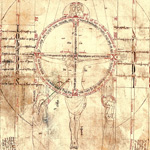Above: Jean Pucelle (active ca. 1320–1324) Saint Louis Feeding the Sick from The Book of Hours of Jeanne d’Evreux Paris, France, 1324–28, 3 1/2 x 2 5/8 in. (8.9 x 6.2 cm), The Metropolitan Museum of Art, New York; The Cloisters Collection, 1954 (54.1.2); Opicinus de Canistris (1296–ca. 1354) Diagram with Crucifixion, Avignon, France; 1335–50, Biblioteca Apostolica Vaticana, Vatican City, Pal. Lat. 1993.
In last week’s post I discussed the earliest drawings in the exhibition, the initials in the Corbie Psalter, which date to around 800. I began the exhibition with this work because I have long felt the two anonymous scribe-artists responsible for the book were among the first great medieval draftsmen. They understood the power of the drawn line. Their expressive impulse seemed to derive organically from the words they were writing.
As the exhibition enters its final week, I have been thinking about the very last drawings in the show, works which were created more than five hundred years after the Corbie Psalter. One is the exquisite, astonishingly tiny Hours of Jeanne d’Evreux, a masterpiece by Jean Pucelle. Every aspect of this prayer book, a gift from King Charles IV of France to his queen, Jeanne d’Evreux, some time between 1324 and 1328, seems designed to provoke wonder. Its parchment, of exceptional creaminess and suppleness, is so thin at places as to be translucent. The sheer number of illustrations and the variety and inventiveness of the images, particularly in the margins, yield endless delight. Using a fine pen and brush to apply iron gall ink, black carbon ink, and lead white pigment, Jean Pucelle creates nuanced contours and delicate lines. He often sets the figures against richly colored backdrops to make their sculptural qualities all the more apparent. The elegance of the manuscript is undeniable.
Another body of work, which couldn’t be more different from the Hours of Jeanne d’Evreux, is the mesmerizing set of drawings from the portfolio of Opicinus de Canistris created around 1335–50. Drawing on both sides of unwieldy, imperfect, and untrimmed pieces of parchment, Opicinus conveyed his own understanding of the structure of the cosmos through an idiosyncratic set of diagrams. The visionary cleric drew upon the medieval diagrammatic tradition to be sure, but he pushes that tradition to an extreme, creating an almost hallucinatory effect. Within a geometric matrix, he places bodies within bodies (”like Russian dolls,” as one visitor remarked). Text—allusive explanations, word games, snatches of autobiography—operate independently on the page, sometimes shifting in orientation. For all his seemingly inscrutable organizational schemes, he is a fine draftsman, and part of the pleasure of viewing his works derives from discovering the subtly rendered figures hidden in them. In one instance, a close look beneath a dense network of radial lines reveals a delicate pair of crucifixions.
While grounded in medieval traditions of draftsmanship, both of these works anticipate attributes and uses of drawings typically associated with the Renaissance. The illustrations in the prayer book show an engagement with the material world—an interest in direct observation and illusionistic space. Virtuosity, achieved through pen and ink, is an end unto itself. Opicinus uses drawings to express an intensely private vision, all the while engaging with the artistic currents of his day. His drawings record the feverish workings of his mind.
Well before the “Old Masters,” we find older masters still.
—Melanie Holcomb
Tags: crucifixion, Hours of Jeanne d'Evreux, jean pucelle, Opicinus de Canestris, saint louis


